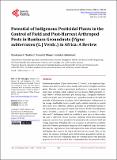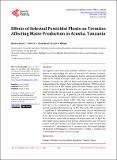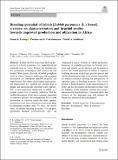Search
Now showing items 1-10 of 101
Potential of Indigenous Pesticidal Plants in the Control of Field and Post-Harvest Arthropod Pests in Bambara Groundnuts (Vigna subterranea (L.) Verdc.) in Africa: A Review
(Science Publishing Group, 2020-05-28)
Bambara groundnuts (Vigna subterranea (L.) Verdc.) is an important leguminous crop native in Africa and is mainly cultivated for its highly nutritious
grains. However, bambara groundnuts production is constrained by ...
Effects of Selected Pesticidal Plants on Termites Affecting Maize Production in Arusha, Tanzania
(Scientific Research Publishing Inc., 2020-03-27)
Investigations under laboratory and field conditions were carried out with
purpose of understanding the effects of pesticides of Cupressus lusitanica,
Tephrosia vogelii, Eucalpytus dalrympleana, Lantana camara and ...
Prospects of Using Termite Mound Soil Organic Amendment for Enhancing Soil Nutrition in Southern Africa
(MDPI, 2020-05-20)
Termite mound soils are reportedly utilized as an alternative to NPK fertilizers by cash
constrained smallholder farmers in some parts of Southern Africa. However, there is limited
knowledge regarding their mineral ...
Breeding potential of lablab [Lablab purpureus (L.) Sweet]: a review on characterization and bruchid studies towards improved production and utilization in Africa
(Springer Netherlands, 2021-09-22)
Lablab (Lablab purpureus) [Lablab purpureus (L.) Sweet] is termed a lost, underutilized and neglected crop in Africa. Despite the multipurpose use, production, consumption and research are still limited. Wide genetic ...
Influence of Tobacco Plant on Macronutrient Levels in Sandy Soils
(MDPI, 2020-03-19)
Tobacco (Nicotiana tabacum L.) is associated with great uptake of soil macronutrients.
Following the need to understand the macronutrients levels before and after tobacco cultivation,
research was conducted in loamy sand ...
Mechanisms for salmonella infection and potential management options in chicken
(The Journal of Animal and Plant Sciences, 2020-03-02)
Salmonella enterica is the largest species in genus Salmonella with its serovars responsible for infection in chickens and
other warm-blooded hosts. After oral ingestion, Salmonella penetrates the mucosal layer of the ...
Selected Insect Pests of Economic Importance to Brassica oleracea, Their Control Strategies and the Potential Threat to Environmental Pollution in Africa
(MDPI, 2020-05-08)
The most common destructive insect pests affecting cabbages in African smallholder
farmers include Plutella xylostella, Helula undalis, Pieris brassicae, Brevycoryne brassicae, Trichoplusia ni
and Myzus persicae. Those ...
Assessment of the Knowledge, Perceptions, and Reactions towards the African Apefly (Spalgis lemolea lemolea) in Tanzania
(MDPI, 2020-01-28)
This paper reports on farmers’ knowledge, perceptions, and reactions towards the African apefly (Spalgis lemolea lemolea), which appeared to be associated with some vegetables in some locations in Tanzania. Information was ...
Agro-Morphological Exploration of Some Unexplored Wild Vigna Legumes for Domestication
(MDPI, 2020-01-13)
The domestication of novel or hitherto wild food crops is quickly becoming one of the
most popular approaches in tackling the challenges associated with sustainable food crop production,
especially in this era, where ...
Environmental and genotypes influence on seed iron and zinc levels of landraces and improved varieties of common bean (Phaseolus vulgaris L.) in Tanzania
(Elsevier, 2020-05)
Phaseolus vulgaris L. (common bean) is a grain legume rich in proteins and micronutrients particularly iron and zinc. This study determined the concentration of iron and zinc in 99 common bean genotypes (landraces and ...










